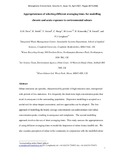JavaScript is disabled for your browser. Some features of this site may not work without it.
| dc.contributor.author | Drew, Gillian H. | - |
| dc.contributor.author | Smith, Richard | - |
| dc.contributor.author | Gerard, Valerie | - |
| dc.contributor.author | Burge, C. | - |
| dc.contributor.author | Lowe, M. | - |
| dc.contributor.author | Kinnersley, R. | - |
| dc.contributor.author | Sneath, R. | - |
| dc.contributor.author | Longhurst, Philip J. | - |
| dc.date.accessioned | 2012-01-30T23:04:12Z | |
| dc.date.available | 2012-01-30T23:04:12Z | |
| dc.date.issued | 2007-04-01T00:00:00Z | - |
| dc.identifier.citation | G.H. Drew, R. Smith, V. Gerard, C. Burge, M. Lowe, R. Kinnersley, R. Sneath and P.J. Longhurst, Appropriateness of selecting different averaging times for modelling chronic and acute exposure to environmental odours, Atmospheric Environment, Volume 41, Issue 13, April 2007, Pages 2870-2880. | - |
| dc.identifier.issn | 0004-6981 | - |
| dc.identifier.uri | http://dx.doi.org/10.1016/j.atmosenv.2006.09.022 | - |
| dc.identifier.uri | http://dspace.lib.cranfield.ac.uk/handle/1826/1768 | |
| dc.description.abstract | Odour emissions are episodic, characterised by periods of high emission rates, interspersed with periods of low emissions. It is frequently the short term, high concentration peaks that result in annoyance in the surrounding population. Dispersion modelling is accepted as a useful tool for odour impact assessment, and two approaches can be adopted. The first approach of modelling the hourly average concentration can underestimate total odour concentration peaks, resulting in annoyance and complaints. The second modelling approach involves the use of short averaging times. This study assesses the appropriateness of using different averaging times to model the dispersion of odour from a landfill site. We also examine perception of odour in the community in conjunction with the modelled odour dispersal, by using community monitors to record incidents of odour. The results show that with the shorter averaging times, the modelled pattern of dispersal reflects the pattern of observed odour incidents recorded in the community monitoring database, with the modelled odour dispersing further in a north easterly direction. Therefore, the current regulatory method of dispersion modelling, using hourly averaging times, is less successful at capturing peak concentrations, and does not capture the pattern of odour emission as indicated by the community monitoring database. The use of short averaging times is therefore of greater value in predicting the likely nuisance impact of an odour source and in framing appropriate regulatory controls. | en_UK |
| dc.language.iso | en_UK | - |
| dc.subject | Odour | en_UK |
| dc.subject | Annoyance | en_UK |
| dc.subject | Dispersion modelling | en_UK |
| dc.subject | Averaging times | en_UK |
| dc.title | Appropriateness of selecting different averaging times for modelling chronic and acute exposure to environmental odours | en_UK |
| dc.type | Article | - |
Files in this item
This item appears in the following Collection(s)
-
Staff publications (SAS) [907]
